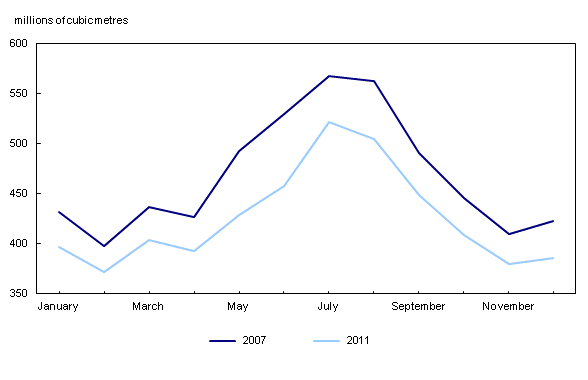Survey of Drinking Water Plants, 2011
Archived Content
Information identified as archived is provided for reference, research or recordkeeping purposes. It is not subject to the Government of Canada Web Standards and has not been altered or updated since it was archived. Please "contact us" to request a format other than those available.
Released: 2013-05-29
In 2011, drinking water plants produced 5 103 million cubic metres of potable water, the equivalent of over two million Olympic-sized swimming pools. That total is down 9% from 2007, when the previous survey was conducted. The principal user of water, the residential sector, averaged 251 litres per person per day in 2011.
Total per capita use averaged 483 litres per person per day in 2011, down 12% from 550 litres per person per day in 2007. The decline in total per capita water use was influenced by both an increase in population and a decrease in drinking water demand.
Surface water sources, such as lakes and rivers, supplied 89% of the water, with groundwater and other sources making up the rest.
A total of 29 million people received their drinking water from plants that served communities of 300 or more people. Just over 25 million of these people received drinking water obtained from surface water sources.
The combined industrial, commercial, institutional and other non-residential sectors used 21% of the drinking water produced. Nationally, 18% of total water volume use was reported as "unknown" and could not be allocated to a particular sector. The remaining portions of water use were reported as losses or water provided to other jurisdictions.
In 2011, most of the water treated by drinking water plants was filtered and disinfected. Overall, 1% of the population received untreated water, which came primarily from groundwater sources. Chlorination, a disinfection process, was applied to 96% of all drinking water produced.
Capital expenditures up
In 2011, $1,336 million in capital expenditures were made to upgrade existing infrastructure and commission new water treatment plants.
These upgrades included improvements to buildings, machinery, processing equipment and other physical assets related to the acquisition and treatment of water, but not its distribution. Capital expenditures in 2011 were up 51% from the amount reported in 2007.
Labour largest component of operation and maintenance costs
In 2011, $882 million was spent on operation and maintenance. These costs include expenditures on materials (chemicals and replacement parts), labour and energy, but exclude water distribution costs.
Labour costs were the largest component of these expenses, at $338 million, while materials accounted for $213 million and energy, $200 million. Other costs made up the remaining $130 million. Total operation and maintenance costs were 9% higher than in 2007.
Note to readers
The Survey of Drinking Water Plants collects data on several water quality parameters to provide information about the quality of source water used by drinking water plants in Canada. The data represent source water quality in the environment before treatment and not final drinking water quality. Source water quality results are based on the plants that reported data for the given parameter and apply only to the water processed and the population served by those plants.
The publication Survey of Drinking Water Plants Survey Report, 2011 (Catalogue number16-403-X), is now available. From the Browse by key resource module of our website under Publications, choose All subjects, then Environment.
Contact information
For more information, contact us (toll-free 1-800-263-1136; infostats@statcan.gc.ca).
To enquire about the concepts, methods or data quality of this release, contact Terence Nelligan (613-951-3886; terence.nelligan@statcan.gc.ca), Environment Accounts and Statistics Division.
- Date modified:


